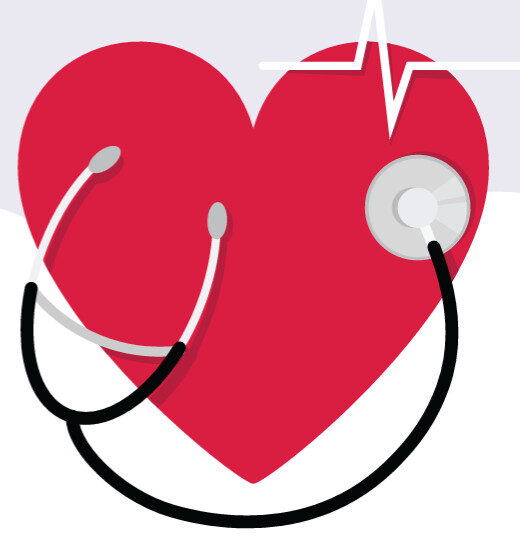Home » Hypertension, the Silent Killer

Hypertension is one of the leading causes of death from cardiovascular disease and is the most important modifiable risk factor for all-cause morbidity and mortality globally. The number of adults aged 30-79 years with hypertension has increased from 680 million to 1.28 billion in the last 30 years. A recent Lancet paper showed that in Ireland the prevalence of high blood pressure in men was 38.2 per cent. Research from the Irish Longitudinal Study on Ageing (TILDA), has also estimated that 64 per cent of people over 50 in Ireland have high blood pressure. Worryingly, almost half of people on medication for hypertension didn’t have adequate blood pressure control and 45 per cent of people were unaware that they have high blood pressure. Furthermore, in Ireland we have lower rates of treated and controlled BP when compared to the UK and Canada.
“Opportunistic screening should be done at least every three years in those less than 40 years of age and every year over 40 years of age.”
Importantly, hypertension is asymptomatic in most people, hence the term the ‘Silent Killer’. Uncontrolled hypertension leads to a seven times increased risk of stroke and contributes to 70 per cent of all strokes. It also accounts for a six times increased risk of heart failure, increases the risk of myocardial Infarction, renal failure, atrial fibrillation, retinopathy, impotence, and also increases the risk of dementia the higher the BP the greater the risk. Prevalence increases in lower socioeconomic groups and is rising across the world as well as in Ireland. We are seeing this because of our ageing population, rising levels of obesity, sedentary lifestyles, insulin resistance, and the higher intake of processed foods and alcohol.
As so many patients are unaware that they have high BP raising awareness is crucial; empowering people to get their BP checked, to know what their BP is and what it should be is vital in improving these statistics. Opportunistic screening should be done at least every three years in those less than 40 years of age and every year over 40 years of age. If blood pressure is suboptimal then it needs to be checked more frequently.
To diagnose hypertension accurately, three BP measurements should be recorded, with a validated and calibrated device one to two minutes apart, and additional measurements should be performed if the first two readings differ by >10mmHg, and an average of the last two readings is taken. Where screening office BP is 140–159/90–99 mmHg, ideally the diagnosis of hypertension should be based on out-of-office BP measurement with a 24-hour BP monitor and/or a home BPM. Where screening office BP is 160–179/100–109 mmHg it should be confirmed as soon as possible (i.e., less than one month), preferably by either home or ambulatory BP measurements. If the BP is ≥180/110 mmHg, it is important that a hypertensive emergency is excluded. It is more difficult to use an automated monitor and take accurate measurement in AF, so a manual auscultatory method should be used if available. In patients with dizzy spells or syncope an assessment for orthostatic hypotension is made, (this is a ≥20 systolic BP and/or ≥10 diastolic BP mmHg drop at one and/or three minutes min after standing). This is performed after the patient has been lying or sitting for five minutes.
The latest ESC guidelines suggest a normal BP is less than 120/70mmhg and an elevated BP is between 120/70mmHg to 139/89mmHg, with hypertension diagnosed at equal or greater than 140/90mmHg. It is recommended that everyone is risk stratified – for example, high-risk individuals are those with diabetes, moderate to severe renal impairment, known vascular disease, evidence of end organ damage and familial hypercholesterolaemia. High-risk individuals would have more rigorous blood pressure control targets.
During the initial assessment of people with hypertension routine investigations will be done, including a renal profile, eGFR, Lipids. Haematocrit, blood glucose, calcium thyroid function, urine analysis and urine albumin to creatinine ratio. An ECG will be performed and often an Echo to assess for left ventricular hypertrophy and help exclude an aortic coarctation. In patients suspected of secondary hypertension further investigations may be carried out to exclude cushings, phaeochromocytoma, primary aldosteronism, obstructive sleep apnoea, etc. Depending on these results, some individuals may go onto have a renal USS and/or an MRI of the kidneys, renal arteries and adrenal glands. Most patients have essential or primary hypertension where the cause is unknown. 10 per cent have secondary hypertension with an identifiable cause so treatment entails treating the primary cause.
All individuals should be given advice on non-pharmacological interventions. This would include moderate intensity aerobic exercise of ≥150 min/week (≥30 min, five to seven days/week), or alternatively 75 min of vigorous intensity aerobic exercise per week over three days, complemented with low- or moderate-intensity dynamic or isometric resistance training (two to three times/week) to reduce BP and CVD risk. Ideally, advice would be to aim for a stable BMI (20–25 kg/m2 ) and waist circumference values (<94cm in men and <80cm in women). Adopting a healthy and balanced diet such as the Mediterranean or DASH diet, reducing processed foods and cutting down on salt and increasing potassium rich foods. Reducing alcohol intake and stopping smoking are all important aspects.
In some cases, individuals with an elevated BP who are at high risk (a 10-year predicted risk of CVD events of >10 per cent) may require pharmacological treatment if lifestyle measures are insufficient after three months and the BP remains at or above 130/80mmHg. The majority of individuals with hypertension, once confirmed, will require medical management.
For those people who need medication, ACE inhibitors, ARBs, dihydropyridine CCBs, and diuretics (thiazides and thiazide-like drugs such as chlorthalidone and indapamide) are effective reduction of BP and CVD events, and are used as first-line treatments to lower BP. If the BP is not controlled with a three-drug combination, spironolactone or, if not tolerated, other diuretics such as amiloride or higher doses of other diuretics, a beta-blocker, or an alpha-blocker are used. If the BP is still not controlled with a three-drug combination and if spironolactone is not effective or tolerated, treatment with eplerenone instead, or the addition of a beta-blocker if not already instigated and, next, a centrally acting BP-lowering medication, an alpha-blocker, hydralazine, or a potassium-sparing diuretic is considered.
Sympathetic nervous system overactivity contributes to the development and progression of hypertension. Renal denervation aims to interrupt afferent and efferent sympathetic nerves in the adventitia and perivascular tissue of the renal arteries. Catheter based renal denervation may be offered to patients with uncontrolled hypertension despite three BP lowering drugs after careful discussion.
Pharmacists can play a critical role in the management of hypertension by working collaboratively with their patients, and prescribers to help detect hypertension via screening services, and improve BP control though medicines optimisation and patient education, which in turn can prevent complications developing.
Many pharmacies provide hypertension screening services though blood pressure checks; screening can provide an opportunity to discuss risk factors and health concerns with patients, as well as educating them on the benefits of non-pharmacological management such as smoking cessation, diet and exercise, and providing information on what their blood pressure values should be, and the importance of getting regular blood pressure checks.
Pharmacists are experts in medication management and can work with patients to optimise their medication regimens to improve BP control.
Non-adherence to antihypertensive therapy is one of the major barriers for the achievement of blood pressure (BP) control. As there is a high incidence of suboptimal blood pressure control, understanding poor adherence is an important issue. Estimated adherence to medication is less than 50 per cent. The WHO describes five dimensions of adherence:
All of these factors need to be addressed to enable patients to manage their hypertension successfully.
In practice pharmacists can play an active role in identifying patients who may be nonadherent to their regimens. Pharmacists should work closely with their patients to understand and address the underlying factors that contribute to nonadherence, such as forgetfulness, medication side effects, and cost concerns, among others.
To try and reduce the issues with polypharmacy and non adherence, a single pill fixed dose drug combination can reduce pill burden, provide cost reduction and improve adherence.
Another service pharmacists provide is to help monitor patients’ BP and provide regular feedback to patients, this can be especially useful in high risk patients or frail older patients to prevent postural hypotension, syncope or falls and help reduce the risk of side effects.
Improving blood pressure control in the population will take a multidisciplinary approach to include all healthcare professionals. Pharmacists play an increasingly important role in both raising awareness, education and management of this patient population.
References are available on request.
Dr Angie Brown

Medical Director of the Irish Heart Foundation and Consultant Cardiologist
Highlighted Articles